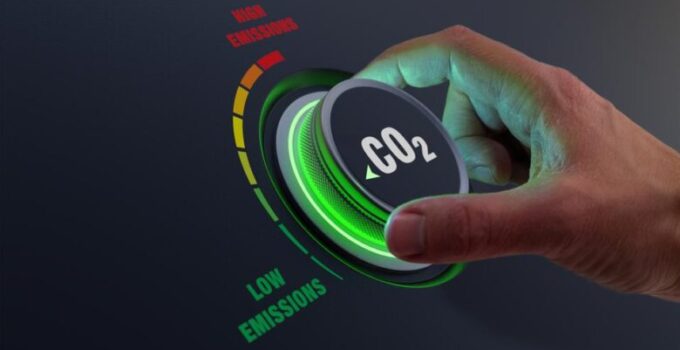With the growing global climate crisis, now is the time to assess how technologies can be used to help reduce carbon emissions and create a more sustainable world. As a society, we are rapidly embracing innovative new solutions, but are we asking the right questions?
In this blog, we’ll explore how technology can help us understand and mitigate the effects of climate change and make our planet a healthier place for generations to come. So grab your laptop (or phone) and let’s get started on this exciting journey!
The Impact of Carbon Emissions on the Environment
Carbon dioxide (CO2) is the primary source of global warming and climate change. Increasing concentrations of carbon dioxide in the atmosphere are altering weather patterns, increasing the frequency and intensity of extreme weather events such as hurricanes, floods, and droughts. These changes also cause serious threats to humans and our food supply as rising water levels contaminate agricultural fields, bring new insects into our homes, and create physical barriers that limit access to resources.
To reduce CO2 emissions from cars, homes, and businesses, some countries are implementing policies such as carbon taxes or cap-and-trade systems. In addition to government interventions, technological advancements have had a major impact on reducing CO2 emissions. To learn more about your carbon footprint and how to stay carbon positive, you can find more information here.

Source: greenmatters.com
The development of renewable energy sources such as solar or wind has allowed us to produce electricity without burning fossil fuels like coal or natural gas. Furthermore, advances in energy efficiency allow households to reduce their electricity use without necessarily reducing their comfort level—by switching to LED light bulbs or investing in smarter thermostats that control heating and cooling systems automatically.
Finally, by using electric vehicles powered by batteries instead of combustion engines we can contribute significantly towards reducing atmospheric pollution—avoiding hazardous exhaust gases emitted by petrol- or diesel-powered vehicles.
Technologies to Reduce Carbon Emissions
Reducing emissions can be done through ecology-based solutions – for example, planting trees or conserving energy – or by reducing our heavy dependence on fossil fuels in favor of alternative sources. Technology plays a major role in reducing emissions. Here are some of the technologies that have been developed or adapted to tackle climate change:
- Renewable Energy: Renewable energy is any energy source that is inexhaustible such as solar, wind, and geothermal power. It can complement existing electricity grids and there are various incentives available in some countries to install solar systems. By utilizing renewable energy sources instead of traditional fuels like coal and oil, we can significantly reduce carbon emissions.
- Electric Vehicles: Electric vehicles are powered entirely by electricity instead of gasoline or diesel fuel, meaning their exhaust does not contain any polluting carbon dioxide or toxic fumes. By using electric vehicles with energy coming from renewable energy sources (i.e., solar panels), you can both reduce your own vehicle’s emissions and contribute to building a cleaner electrical grid power system as a whole.
- Smarter Homes: Smart homes use technology such as sensors, connected appliances, smart thermostats, automated lighting systems, and others to reduce waste heat from inefficient operation – which would otherwise be released into the environment as a heat-trapping greenhouse gas like carbon dioxide –contributing to global warming. On top of being more environmentally friendly than traditional homes, smart technology can help you save money on home bills too!
- Smart Industry: Smart industry involves using digitization for managing resources more efficiently by monitoring usage data in real-time using sensors and Internet-of-things systems. By implementing real-time tracking systems for raw materials used in factories during production processes we can zero out human-induced waste like gas leakage from production factories without compromising efficiency levels thereby reducing hazardous carbon pollution into the environment significantly over time.
Benefits of Reducing Carbon Emissions
On a larger scale, decreasing these emissions will lead to a healthier planet and slower climate change. By utilizing technology to reduce emissions that contribute to global warming, we can diminish the effects of increasing temperatures on the environment, protect ecosystems and conserve resources.
At the household level, technological advancements can help in reducing the amount of energy we use. Energy-efficient appliances such as washing machines and refrigerators require less energy than their counterparts from decades ago and are more cost-effective in the long run. In addition, adopting smart thermostats can also help households save money by adjusting temperatures based on occupancy levels or activity times. Other energy-efficient technologies such as electric vehicle charging systems or efficient HVAC systems designed for homes can also help in reducing home energy consumption and CO2 emissions.
Overall, employing technology to reduce carbon emissions is essential for preserving our environment, conserving resources, and lowering our bills. Taking small steps today will ensure a better tomorrow for generations to come.
Government Policies to Encourage Carbon Emission Reduction
Organizations can benefit from tax credits, grants, and other funding opportunities that provide financial assistance for efforts like energy efficiency or renewable energy development. Policies like cap-and-trade regimes, carbon taxes, and pricing help put a cost on carbon itself, making it more expensive for emitters to send polluting gases into the atmosphere. Governments can also adopt technology requirements, such as mandating fuel economy standards or requiring more efficient building codes.

Source: benchmarkdigitalesg.com
Technology can provide useful insights into where emission reduction efforts would be most effective and how policies should be designed to achieve significant reductions in greenhouse gases. For example, satellite images show which areas are emitting higher amounts of CO2 due to human activity such as deforestation or burning of fossil fuels. Data analysis tools provide insights into trends in energy consumption over time on both city-wide and global scales. These kinds of tools can help policymakers make decisions about which measures should be prioritized when addressing carbon emissions reduction goals.
Conclusion
Many organizations have already implemented measures that use technology to improve their environmental performance which serves as an example for others.
As the adoption of technology continues to grow, it is important for organizations to continually evaluate their processes and assess new technologies that offer significant potential for reducing carbon emissions. By utilizing the power of technology and taking advantage of best practices within their industry, organizations can make significant strides in reducing their environmental impact and contribute to a more sustainable future for us all.

Source: earth.org




